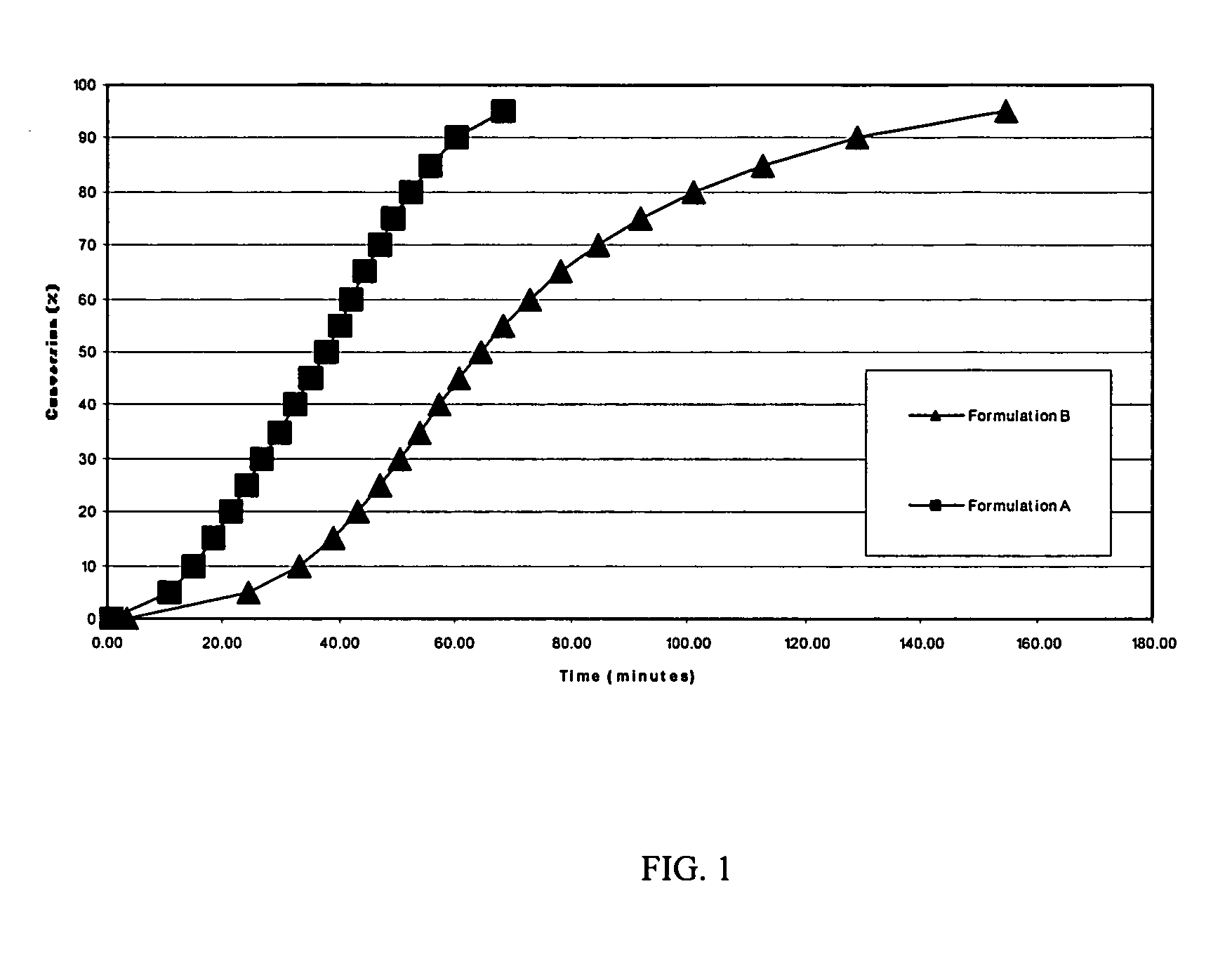Cure accelerators
a technology of accelerators and accelerators, applied in the field of cure accelerators, can solve the problems of increasing the timescale the failure of the cure of epoxy resin formulations to cure within the practical useful timescale at low temperatures, and the inability of compounds to act as accelerators for the imidazole-epoxy reaction, so as to reduce the gel time
- Summary
- Abstract
- Description
- Claims
- Application Information
AI Technical Summary
Benefits of technology
Problems solved by technology
Method used
Image
Examples
example 1
[0039] 1.0 g of 1-(1-imidazolyl)-2-hydroxyoctadecane, Curative I, a latent imidazole curative which is the subject of EP 0906927 B1 was added to 8.0 g of Epikote 828 a diglycidyl ether of bisphenol-A supplied by Resolution Resins, Rotterdam, Holland, 1.0 g of a specified imidazole curing accelerator was added to the mixture to provide a test sample. All of the accelerators were obtained from Aldrich Chemical Company, Gillingham, UK. Each test sample was subjected to gel time experiments that were performed at 80° C. in a thermostated oil bath on 10 g of the test sample referred to above. The gel time was determined manually to be the time when the liquid test sample became elastic.
[0040] A control sample (the chosen imidazole plus resin, with no added accelerator) was run along with each set of test samples. The gel times were normalised within each set by dividing the accelerated gel time by the control gel time.
[0041] A second series of gel experiments were conducted whereby Cur...
example 2
[0043] 1.0 g of Curative I was added to 8.0 g of Epikote 828. 1.0 g of a specified imidazole cure accelerator was added to the mixture to provide test samples. The test samples were subjected to the gel experiments described above. The results are shown in table 2.
TABLE 2Cure AcceleratorGel Time Relative to ControlBenzoic hydrazide0.38p-Toluic hydrazide0.42m-Toluic hydrazide0.40m-Anisic hydrazide0.402-Chlorobenzoic hydrazide0.412-Nitrobenzoic hydrazide0.392-Furoic hydrazide0.391-Naphthoic hydrazide0.45N-Methylbenzamide0.83N-Methyltoluamide0.82
[0044] It can be seen that lower molar mass hydrazides have a more marked effect upon the acceleration of the cure than either the benzamides or the sulfonamides.
example 3
[0045] Differential Scanning Calorimetry (DSC) studies were carried out to examine the rate of conversion of formulations containing cure accelerators. By way of example, the following formulations were subjected to both dynamic and isothermal DSC studies. LY1556 is an epoxy resin available from Huntsman Advanced Materials, Duxford, England
TABLE 3AdditiveFormulation AFormulation BLY15568.43 g9.7 g2-phenylimidazole0.30 g0.3 gN-ethyltoluenesulfonamide (ETS)1.27 g—
[0046] A Mettler Toledo Differential Scanning Calorimeter (DSC), model DSC822E, was used to measure the total reaction enthalpy from each of the formulations. The evaluations were carried out in dynamic mode from −35° C. to +250° C. at 20° C. per minute heat up rate. Formulation A was found to have a total reaction enthalpy of 360-J / g, whilst formulation B was found to have a reaction enthalpy of 310 J / g despite having 15% more resin present. While not wishing to be bound by this theory, this could indicate that perhaps the...
PUM
| Property | Measurement | Unit |
|---|---|---|
| temperature | aaaaa | aaaaa |
| reaction enthalpy | aaaaa | aaaaa |
| temperature | aaaaa | aaaaa |
Abstract
Description
Claims
Application Information
 Login to View More
Login to View More - R&D
- Intellectual Property
- Life Sciences
- Materials
- Tech Scout
- Unparalleled Data Quality
- Higher Quality Content
- 60% Fewer Hallucinations
Browse by: Latest US Patents, China's latest patents, Technical Efficacy Thesaurus, Application Domain, Technology Topic, Popular Technical Reports.
© 2025 PatSnap. All rights reserved.Legal|Privacy policy|Modern Slavery Act Transparency Statement|Sitemap|About US| Contact US: help@patsnap.com

